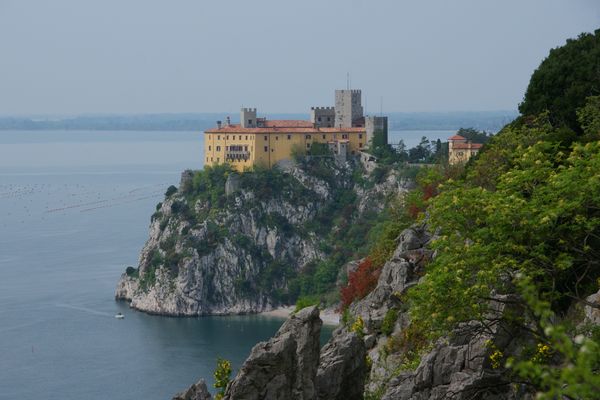A northeastern Italian port city known for its shipbuilding industry, with a 14th-century castle overlooking the Adriatic Sea and ancient Roman ruins at Rocca.
Monfalcone sits along Italy’s northeastern coast in Friuli-Venezia Giulia. Explore the medieval Rocca fortress, find Roman bath ruins inside a working spa, or visit a park with World War I trenches and artillery. The town’s shipyards build large cruise ships and have attracted workers from around the world, creating neighborhoods with halal markets and South Asian restaurants. To the north, limestone hills with caves and trails rise sharply above the flat coastal plain. Monfalcone’s identity comes from industry, ancient ruins, and the meeting of Italian and global cultures.
Rocca Fortress: Medieval Defense and Views
The Rocca fortress stands on a hill above the Gulf of Trieste. Records suggest it existed by the 10th century, though stories claim the Ostrogothic king Theoderic the Great founded it earlier. Venetians rebuilt parts of the structure in the 16th century, creating sharp angles and thick walls designed for defense. Inside, an exhibit explains how the nearby Karst region’s caves and fossils formed over millions of years. Climb the towers to see the shipyards to the south and the Adriatic Sea stretching toward Trieste. This site helps explain how Monfalcone protected trade routes and borders for centuries.
Roman Baths and Modern Spa
Parts of Monfalcone hide remains of Roman villas and public baths from ancient times. Most ruins are closed to visitors, but one set of thermal baths now functions as a modern spa. Workers restoring the spa in 2014 uncovered original mosaic pieces and hypocaust heating systems beneath the floors. Today, you can book treatments in rooms that mix old stone walls with new facilities. These baths show how Romans used natural hot springs here over 1,500 years ago.
World War I Park: Trenches and Trails
Monfalcone’s location near the Austrian front during World War I led to heavy fighting. The World War I park preserves trenches, artillery positions, and signs explaining how the conflict affected the town. Walking paths follow routes soldiers once used, passing through pine forests that now cover former battlefields. The park also marks where bombs destroyed much of Monfalcone during the war, leading to rebuilding in the 1920s. This area gives insight into the region’s wartime struggles and recovery.
Karst Plateau: Caves and Hiking
North of Monfalcone, the Karst plateau’s limestone terrain includes sinkholes, underground rivers, and caves. Guided tours take visitors into Grotta delle Torri di Slivia, known for its stalactites. Trails for hiking or biking cross rocky fields dotted with small wine taverns serving local Refosco wine and prosciutto. The Karst’s dry, rocky environment differs sharply from the flat, industrial coastline below. People come here to explore caves or enjoy quiet walks through unusual geology.
Shipyards and Global Workforce
Monfalcone’s Fincantieri shipyard dominates the southern part of town, building cruise ships and military vessels. The industry began here in the early 1900s, and the Egone Missio Archives keep old ship designs and construction records. Though tours aren’t available, you can view cranes and dry docks from nearby roads. Many workers come from Bangladesh, leading to halal shops and Bengali restaurants in areas like Via San Marco. The shipyards highlight how global industry shapes local life and culture.
Cultural Mix: Daily Life and Food
About 30% of Monfalcone’s population was born outside Italy, with many from Bangladesh working in the shipyards. This mix appears in grocery stores selling spices and lentils, cafes offering chai tea, and evening bike commutes along main streets. Recent discussions about public space use, like restricting cricket games in parks, reveal challenges as the town adapts. Community projects, such as women’s groups teaching Italian and crafts, aim to bridge cultural gaps. The result is a town where South Asian and Italian traditions coexist in markets, schools, and festivals.
Getting Around Monfalcone
Trains connect Monfalcone to Venice (two hours west), Trieste (30 minutes east), and Udine (40 minutes north). Buses run to nearby villages in the Karst and beach areas like Grado. Most central sights—the Rocca, spa, and main shopping streets—are within a 20-minute walk. Rent a bike to reach the shipyard area or follow paths into the Karst. Trieste Airport, 30 minutes south by car, has flights to major Italian cities and a few European hubs.





















